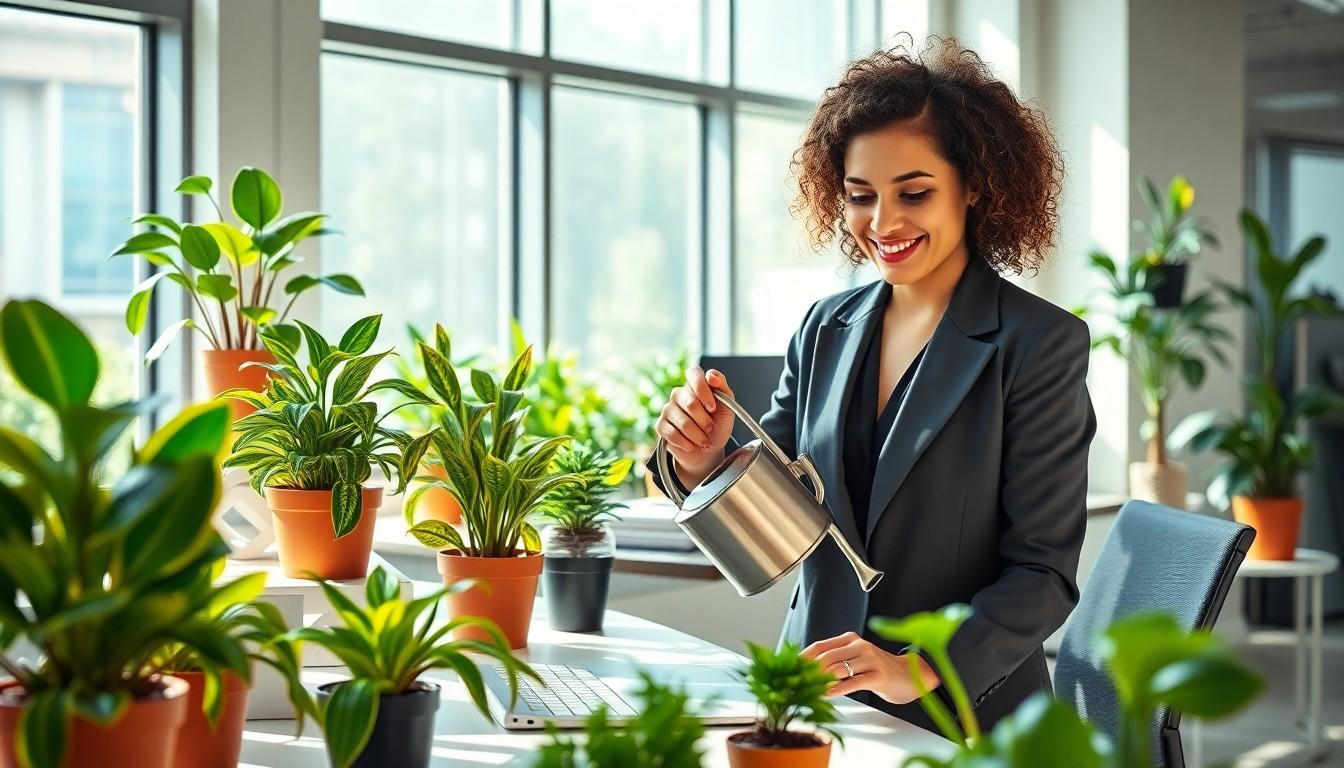Phone:
(701)814-6992
Physical address:
6296 Donnelly Plaza
Ratkeville, Bahamas.

In the hustle and bustle of office life, it’s easy to forget that a little greenery can work wonders. Imagine transforming that bland cubicle into a vibrant oasis where stress takes a backseat and productivity thrives. Indoor plants aren’t just pretty; they’re like tiny air-purifying superheroes, ready to rescue employees from the clutches of stale office air.
Picture this: your desk adorned with a cheerful pothos or a resilient snake plant, bringing life to those endless Zoom calls. Not only do these leafy companions brighten up the space, but they also boost mood and creativity. Who knew that a little foliage could be the secret ingredient to a happier workday? So, let’s dig into the world of indoor plants and discover which ones will make your office feel less like a dungeon and more like a delightful escape.
Indoor plants significantly enrich office spaces, contributing to both emotional and physical well-being.
Indoor plants play a vital role in enhancing air quality. They absorb pollutants, such as formaldehyde and benzene, and release oxygen through photosynthesis. Research indicates that plants can reduce airborne dust levels by up to 20%. Specific plant varieties, like peace lilies and spider plants, thrive in low light and help filter harmful substances. Clean air leads to healthier employees who experience fewer headaches and respiratory issues. Incorporating these plants can promote a more comfortable workspace, benefiting everyone.
Studies show that indoor plants boost productivity levels among office workers. A workspace adorned with greenery promotes focus and concentration, leading to better task performance. Employees report increased creativity by 15% in environments enriched with plants. Additionally, exposure to nature stimulates brain activity and reduces stress, allowing for a more effective work dynamic. Incorporating plants can create a stimulating atmosphere, ultimately yielding higher output and job satisfaction in the workplace.

Selecting the right indoor plants can significantly enhance an office’s atmosphere. Consider both low-light and easy-care options for optimal results.
Low-light plants thrive in spaces with minimal sunlight. Snake plants adapt well to dimly lit areas and require little maintenance. ZZ plants also handle low light efficiently, making them perfect for offices with limited windows. Pothos not only tolerates low light but also improves air quality. These plants contribute to a healthier workplace by absorbing toxins and releasing oxygen.
Easy-care plants suit busy office environments. Spider plants survive neglect and can tolerate varying light conditions. Peace lilies require minimal watering while producing beautiful white flowers. Cast iron plants handle harsh conditions, making them virtually indestructible. Each of these choices adds greenery without demanding excessive attention, ensuring they flourish even in a hectic office.
Caring for indoor plants in an office ensures they thrive and brings benefits to the workspace. Understanding specific requirements helps maintain healthy plants.
Water indoor plants when the top inch of soil feels dry. Overwatering leads to root rot, while underwatering causes wilting. Adjust watering frequency based on environment; warmer offices may require more frequent watering. Consider using self-watering pots to simplify maintenance. Always use well-draining soil to prevent excess moisture buildup. Observe plants for signs of distress, such as yellow leaves, which may indicate watering issues.
Position plants near windows to maximize natural light exposure. Many indoor plants prefer indirect sunlight rather than direct rays. For low-light spaces, choose plants known for their shade tolerance. Snake plants and pothos adapt well to lower illumination. Use artificial grow lights to support plants in darker areas. Place plants away from drafts and air conditioning units to reduce stress. Monitor each plant’s response to its location and adjust accordingly.
Selecting appropriate planters enhances both functionality and aesthetics in an office environment. Thoughtful choices can elevate the overall appeal while ensuring plants thrive.
Size and material significantly impact plant health and office aesthetics. Planters must provide adequate space for root growth, so larger plants need bigger containers. Ceramic, plastic, and metal are common materials; each offers unique benefits. Ceramic planters provide durability and insulation but may be heavier. Plastic planters are lightweight and versatile but might lack elegance. Metal options lend a modern touch, though they can lead to overheating. Choosing the right combination of size and material supports plant vitality while complementing the office decor.
Aesthetic appeal contributes meaningfully to office ambiance. Attractive planters can create a cohesive look by matching the decor style, whether minimalistic, industrial, or vibrant. Consider colors, textures, and shapes that harmonize with furniture and wall colors. Sleek, geometric designs add modern flair, while rustic pots create warmth. Incorporating varied planter heights and styles can introduce visual interest while providing texture to the workspace. Thoughtful planning leads to an inviting atmosphere that fosters creativity and productivity.
Incorporating indoor plants into office spaces is a simple yet effective way to enhance the work environment. They not only improve air quality but also foster a sense of well-being among employees. By selecting the right low-light and easy-care plants, anyone can create a vibrant atmosphere that promotes productivity and creativity.
With proper maintenance and thoughtful planter choices, these green additions can thrive and bring lasting benefits to the workplace. Embracing indoor plants is more than just an aesthetic choice; it’s a commitment to a healthier and more enjoyable office experience.